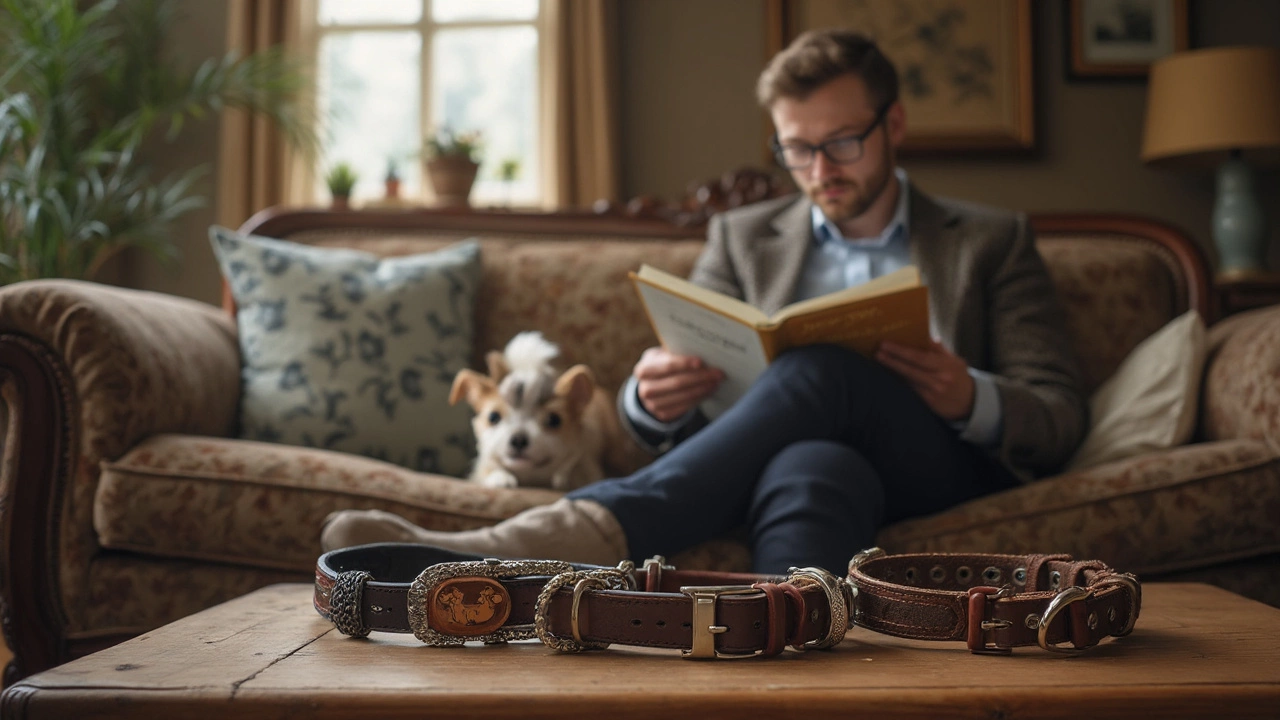Ever feel like walking your dog is more of a workout than a leisurely stroll? You know the scenario: one moment you're sauntering along, and the next, you're being dragged down the street. It's not only exhausting but also risky—for both you and your dog.
Let's dig into some practical solutions. First up, one of the most critical tools in your arsenal is the dog collar. There are loads of options—ranging from flat collars to head halters, and each has its perks and pitfalls. We'll guide you through the most popular choices and how they can help reduce pulling during walks.
Wondering if one collar type can magically solve all pulling problems? Not exactly. Pairing the right collar with effective training techniques is key. We'll share tips on combining them to turn walks into pleasant experiences for both you and your dog. So, if you're ready to swap the pulling circus act for calm, controlled walks, keep reading. We’re here to help you find the perfect collar solution!
- Understanding Dog Collar Options
- Benefits and Downsides: Which Collar Works Best
- Training Tips to Complement Collar Use
- Mistakes to Avoid While Using Collars
- Choosing the Right Collar for Your Dog
Understanding Dog Collar Options
When it comes to stopping that pesky leash pulling, the right dog collar can make a world of difference. But with so many options out there, how do you know which one will actually tame that tug of war? Let's break it down.
Flat Collars
This is your everyday staple. The flat collar is what most dogs start with. It's comfy, easy to put on, and great for wearing around the house. But in terms of controlling pulling? Not so much. They're best for dogs who are already well-mannered on a leash.
Martingale Collars
Originally designed for greyhounds, these collars gently tighten when pulled but stop tightening before they become uncomfortable. They're like a safety net—offering a bit more control than standard flat collars.
Head Halters
If your dog is a real pull-meister, a head halter might be the game-changer you need. It looks like a horse halter and works by guiding your dog’s head, which in turn directs where the body goes. The control it offers is immense, though it can take time for your pup to adjust.
Choke and Prong Collars
These can be controversial, as they tighten around the neck when the dog pulls. Some trainers swear by them, especially for tough cases, but it's crucial to use them under professional guidance to avoid harming your dog.
Harnesses
Though not technically a collar, harnesses are worth mentioning. They're perfect for dogs who need a pulling intervention. A front-clip harness in particular can provide better control and help stop pulling by steering the dog to the side.
No matter which collar you go with, remember it’s about finding the right fit for both you and your furry friend. Dive into options with an open mind and a pinch of patience, and soon those walks might just become relaxing strolls.
Benefits and Downsides: Which Collar Works Best
Choosing the right dog collar can be a bit overwhelming, right? They come in all shapes and sizes, and each promises to be the holy grail of stopping leash pulling. Let’s break down a few popular options to see what they offer.
Flat Collars
These are the most common collars you see on dogs. They're simple, safe for everyday use, and many dogs wear them comfortably. However, when it comes to strong pullers, they might not be your best bet. Without additional control, it can sometimes teach the dog to lean into the pull.
Martingale Collars
Originally made for dogs with narrow heads like Greyhounds, martingale collars tighten when pulled, but not too tight, thanks to their unique design. “Martingales offer just enough tension to control pulling without choking,” says canine expert Sarah Williams.
“They’re a great choice for dogs who tend to slip out of regular collars.”
Head Halters
If you’ve ever seen a dog wearing what looks like a horse halter, that’s a head collar. They provide excellent control by guiding the head, meaning where the head goes, the body follows. It can take a little getting used to, both for you and your dog, but they can be super effective for persistent pullers.
Prong Collars
This one sparks a lot of debates. They're one of those dog collars that should really only be used under the guidance of a professional trainer. They apply pressure around the neck when the dog pulls, which can communicate that pulling is not cool. But misuse can cause harm, so proceed with caution.
Harnesses
Harnesses are quite popular, and rightfully so. Distributed more evenly across the dog's body, they prevent neck injuries and, with front-clip options, can deter pulling effectively. To help navigate this information, check out this comparison:
| Collar Type | Benefits | Downsides |
|---|---|---|
| Flat Collar | Basic and easy to use | Not much control over pulling |
| Martingale Collar | Prevent slipping out | Limited tightening |
| Head Halter | High control over direction | Adjustment period needed |
| Prong Collar | Effective for strong pullers | Risk of neck injury if misused |
| Harness | Even pressure distribution | Can encourage pulling if clipped at back |
Choosing the correct option isn't one-size-fits-all. Consider your dog's behavior and comfort, and maybe even test a few collars to see which one suits them best. Remember, every pup is different!

Training Tips to Complement Collar Use
Using the right dog collar is just one piece of the puzzle. To really stop your dog from pulling, you need to match it with some effective training methods. Let's break it down with some practical steps you can take.
Consistency is Key
Consistency is the bread and butter of training. If you sometimes allow pulling and sometimes correct it, your dog will be confused. Stick to a consistent approach every time you hit the pavement.
Reward the Good Stuff
Praise and treats make a big difference. Whenever your dog walks calmly without pulling, give them a treat or some positive reinforcement. They'll learn that moving nicely by your side earns a reward.
Implement the "Stop and Go" Technique
Here's a classic technique: the "Stop and Go." Every time your dog pulls, stop walking. Wait until they loosen the leash by stepping back towards you or sitting down, then start walking again. They’ll soon realize pulling equals no progress.
Practice Makes Perfect
Don't expect miracles overnight. Spend time each day working on leash manners, even if it's just in your backyard. Gradually increase the difficulty by walking in more distracting environments.
Additional Tips
- No Excitement Before Walks: Before heading out, ensure your dog is calm. Make them sit and only clip the leash on when they're settled. This reduces pre-walk overstimulation.
- Use Positive Commands: Teach commands like "heel" or "easy" to signal they need to pay attention to you.
- Short Leash Training: Start with a shorter leash to keep them closer. Once they improve, you can gradually offer them a bit more slack.
Training takes time, but by sticking with it, you'll transform those tug-of-war walks into peaceful strolls. Remember, the combination of the right collar, such as a head halter or flat collar, and these consistent training tips can make a world of difference for you and your furry friend.
Mistakes to Avoid While Using Collars
Using the right dog collars can make a world of difference, but it's easy to slip up if you're not careful. Steering clear of common pitfalls can help you and your dog enjoy your walks together.
Choosing the Wrong Collar
The first mistake many owners make is picking the wrong type of collar. You might assume a one-size-fits-all approach works, but every dog is unique. For instance, a head halter can be great for a strong dog that pulls, but may not be ideal for nervous or reactive dogs.
Ignoring Fit and Comfort
Another crucial point is the fit. A collar that's too tight can hurt your dog, while one that's too loose might allow them to slip out. Always aim for a snug fit—you should be able to slide two fingers comfortably between the collar and your dog’s neck.
Relying Solely on the Collar
A collar is only part of the solution. Training is vital. Relying on a collar alone without proper training won't fix the problem. Integrating training techniques like positive reinforcement can reinforce your dog's learning.
Overlooking Material and Quality
Don’t cheap out on quality. A collar that breaks during a walk is the last thing you need. Quality materials can ensure durability and safety. Invest in a reliable collar that stands up to wear and tear.
Neglecting Regular Checks
Finally, check the collar regularly. As your dog grows or changes weight, the fit might alter. Regularly inspect for wear and tear, and ensure it's still the appropriate size for your dog.
Avoiding these mistakes can make using dog collars effective and safe. This way, you'll have more time to enjoy peaceful, pleasant walks with your furry friend.

Choosing the Right Collar for Your Dog
Picking the right dog collar feels overwhelming, right? With so many options out there, how do you know which to choose? Let’s break it down so you and your furry friend can enjoy stress-free walks.
Types of Dog Collars
First off, you need to know the types of collars that could help stop your dog from pulling:
- Flat collars: These are your standard dog collars. They’re great for ID tags but not the best option for pullers since they don't offer much control.
- Martingale collars: These gentle cinching collars give a bit more control without choking your dog. Ideal for dogs with narrow heads who slip out of regular collars.
- Head halters: These fit over your dog's snout and attach behind the ears. They redirect your dog’s attention towards you, making them an excellent choice for preventing pulling.
- Harnesses: While not technically collars, no-pull harnesses can work wonders. They distribute pressure across the chest and back, which can deter pulling.
Factors to Consider
So, how do you determine which collar fits the bill?
- Size: Always ensure you measure your dog’s neck accurately before purchasing. A collar should be snug but not too tight—about two fingers should fit between the collar and skin.
- Behavior: Assess if your dog is a strong puller or just needs a little guidance. This will help narrow down the collar choice.
- Material: Look for durable materials. Nylon and leather are popular options; they stand up to wear and tear.
- Comfort: The collar should be comfortable enough for everyday wear. It shouldn’t cause chafing or irritation.
Getting the Fit Right
Imagine you have the perfect collar, but it doesn't stop leash pulling if it’s not fitted correctly. To check:
- Place the collar around your dog's neck and buckle it.
- Slide two fingers under the collar to ensure it's snug.
- Adjust as necessary; it shouldn’t be loose enough for your dog to slip out.
Data to Consider
Did you know that consistent use of a well-fitted collar can reduce pulling by up to 70% in just a few weeks? A survey of dog owners showed most saw improvements within a month of switching collars and combining with basic training.
Final Thoughts
Remember, the right collar is a game-changer, but it’s just one part of the solution. Pair it with training consistently and avoid common mistakes like pulling back when your pup pulls. This way, you’ll make the most of your collar. Happy walking!
